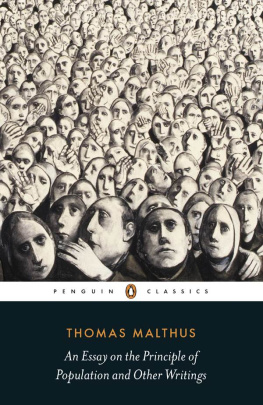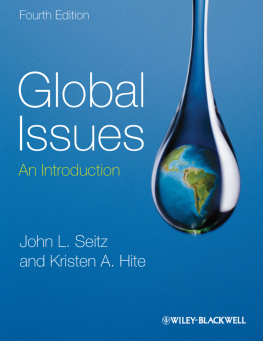From Malthus to The Club of Rome and Back
First published 1994 by M.E. Sharpe
Published 2015 by Routledge
2 Park Square, Milton Park, Abingdon, Oxon 0X14 4RN
711 Third Avenue, New York, NY 10017, USA
Routledge is an imprint of the Taylor & Francis Group, an informa business
Copyright 1994 Taylor & Francis. All rights reserved.
No part of this book may be reprinted or reproduced or utilised in any form or by any electronic, mechanical, or other means, now known or hereafter invented, including photocopying and recording, or in any information storage or retrieval system, without permission in writing from the publishers.
Notices
No responsibility is assumed by the publisher for any injury and/or damage to persons or property as a matter of products liability, negligence or otherwise, or from any use of operation of any methods, products, instructions or ideas contained in the material herein.
Practitioners and researchers must always rely on their own experience and knowledge in evaluating and using any information, methods, compounds, or experiments described herein. In using such information or methods they should be mindful of their own safety and the safety of others, including parties for whom they have a professional responsibility.
Product or corporate names may be trademarks or registered trademarks, and are used only for identification and explanation without intent to infringe.
Library of Congress Cataloging-in Publication Data
Neurath, Paul.
From Malthus to the Club of Rome and back : problems of limits to growth, population control, and migrations / by Paul Neurath.
p. cm.
Includes index.
ISBN 1-56324-407-1.ISBN 1-56324-408-X
1. Population policy. 2. Demography. 3. Malthusianism.
I. Title.
HB883.5.N48 1994 363.dc20
94-8979
CIP
ISBN 13: 9781563244087 (pbk)
ISBN 13: 9781563244070 (hbk)
FROM
MALTHUS
TO THE
CLUB OF ROME
AND BACK
Problems of Limits to Growth,
Population Control,
and Migrations
Paul Neurath
FROM MALTHUS TO THE CLUB OF ROME AND BACK
COLUMBIA UNIVERSITY SEMINAR SERIES
The University Seminars at Columbia University welcomes this study of From Malthus to the Club of Rome and Back: Problems of Limits to Growth, Population Control, and Migrations by Paul Neurath to the Columbia University Seminars Series. The study has benefited from Seminar discussions and reflects the advantages of scholarly exchange provided by the Seminar Movement.
Aaron W. Warner
Director, University Seminars Columbia University
THE FUTURE OF AMERICAN BANKING
James R. Barth, R. Dan Brumbaugh, Jr., and
Robert E. Litan
THE EVOLUTION OF U.S. FINANCE, VOLUME I
FEDERAL RESERVE MONETARY POLICY: 1915-1935
Jane W. DArista
THE EVOLUTION OF U.S. FINANCE, VOLUME II
RESTRUCTURING INSTITUTIONS AND MARKETS
Jane W. DArista
HOW CREDIT-MONEY SHAPES THE ECONOMY
THE UNITED STATES IN A GLOBAL SYSTEM
Robert Guttmann
THE ANTITRUST IMPULSE, VOLUME I AND II
AN ECONOMIC, HISTORICAL, AND LEGAL ANALYSIS
Theodore P. Kovaleff
FROM MALTHUS TO THE CLUB OF ROME AND BACK
PROBLEMS OF LIMITS TO GROWTH, POPULATION
CONTROL, AND MIGRATIONS
Paul Neurath
Contents
To the members of the Columbia University Seminar on Content and Methods of the Social Sciences and to my colleagues at the Institut fuer Soziologie at the University of Vienna
Preface
When I entered my last year of Gymnasium in Vienna over sixty years ago, in 1930, the worlds population had just passed the two-billion mark. I do not recall anybody paying any special attention to this as some kind of a milestone in the history of mankind (save, of course, the appropriate specialists, of whom I knew nothing). It did not make any great splash in the newspapers (as did the passing of the five-billion mark a few years ago) and nobody at school called our attention to it. The worlds population was not yet a topic of general interest.
True enough, some specialists had already been pointing out that populations in the industrialized nations had during the preceding one hundred years or so been growing faster than ever before. (Until about the late eighteenth century they had been growing at rates of 0.3 percent to 0.4 percent per year, but then the rates slowly increased to about 1.3 percent per year by 1933.) That growth was essentially attributed to various improvements that came with the Industrial Revolution: better medical care, better general hygiene, better standards of living. But when the Great Depression of the 1930s brought a decline of the birthrates, concern began turning the other way: in particular, nationalists in various countries began worrying about population decline, if not in absolute, then in relative terms, compared with the populations of potential enemies in future wars.
Our latter-day vocabulary of population bomb and population explosion, etc., was still resting peacefully in the great treasure house of as yet unused propaganda slogans, waiting to be raised by future alarmists. Robert Malthuss claim that man, if not checked from time to time by famine, war, or pestilence, had a tendency to multiply his own numbers faster than he could increase his food supply was, if taught at all, presented as an oddity in the history of classical economics, easily inveighed against by first attacking his databasehe had primarily used figures from the former British colonies in North America and thereby presumably neglected the increase of population through immigrationand then the mathematical formulation: if it was true, as Malthus claimed, that man tends to multiply his own numbers at a geometrical ratio, but could increase his food supply only at an arithmetical one, then we would have all died of starvation long ago instead of still being here in ever growing numbers, having a good laugh at silly old Malthus.
It was by sheer good luck that, while attending Commercial Academy in Vienna in 193132parallel to my first year studying law at the universityI had a quite remarkable teacher of economics, Dr. Michael Kroell, who presented Malthus to us in a way that left an indelible impression. I can still hear Dr. Kroells sonorous voice now, over sixty years later, as he quoted to us Malthuss most famous passage:
A man who is bom into a world already possessed, if he cannot get sustenance from his parents, upon whom he has a just demand... has no business to be where he is. At natures mighty feast there is no vacant cover for him. She tells him to be gone.
I think it was Dr. Kroells impressive presentation that, in connection with social and political interests acquired elsewhere in political movements, created in me an abiding interest in everything having to do with population and its ramifications in other fields. Thus, when a dozen years later, in 1943,1 had to make my choice of subfields for the oral examinations on my way to the Ph.D. in sociology at Columbia University, I took demography as one of them. Then, in 1946, when I joined the Department of Sociology at Queens College in New York, I selected Population Problems as one of the courses I would teach. And I have been teaching it ever since, both in New York and, since my retirement from Queens College in 1977, through the 1980s and into the 1990s at the University of Vienna, where I am still at it.










